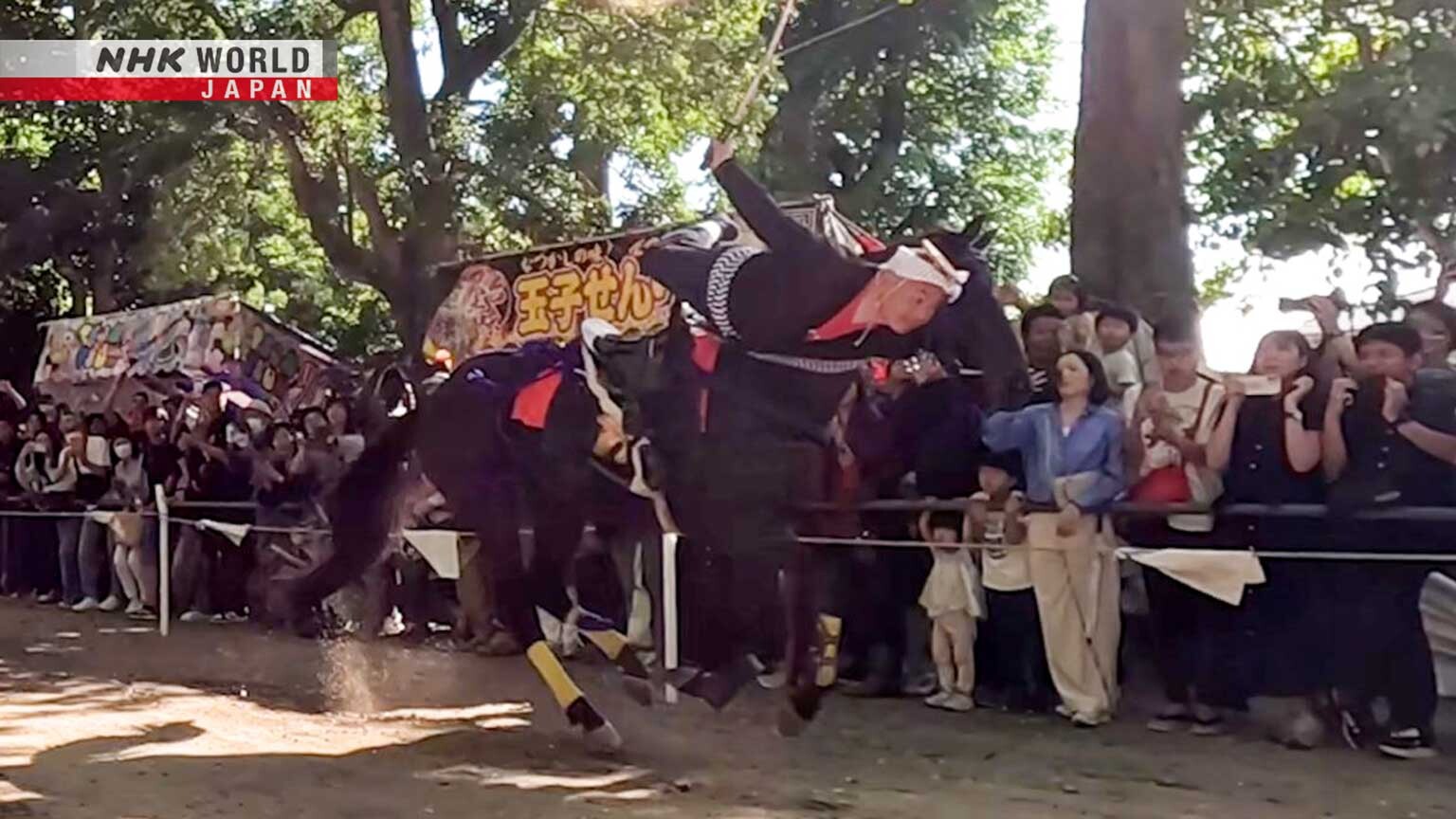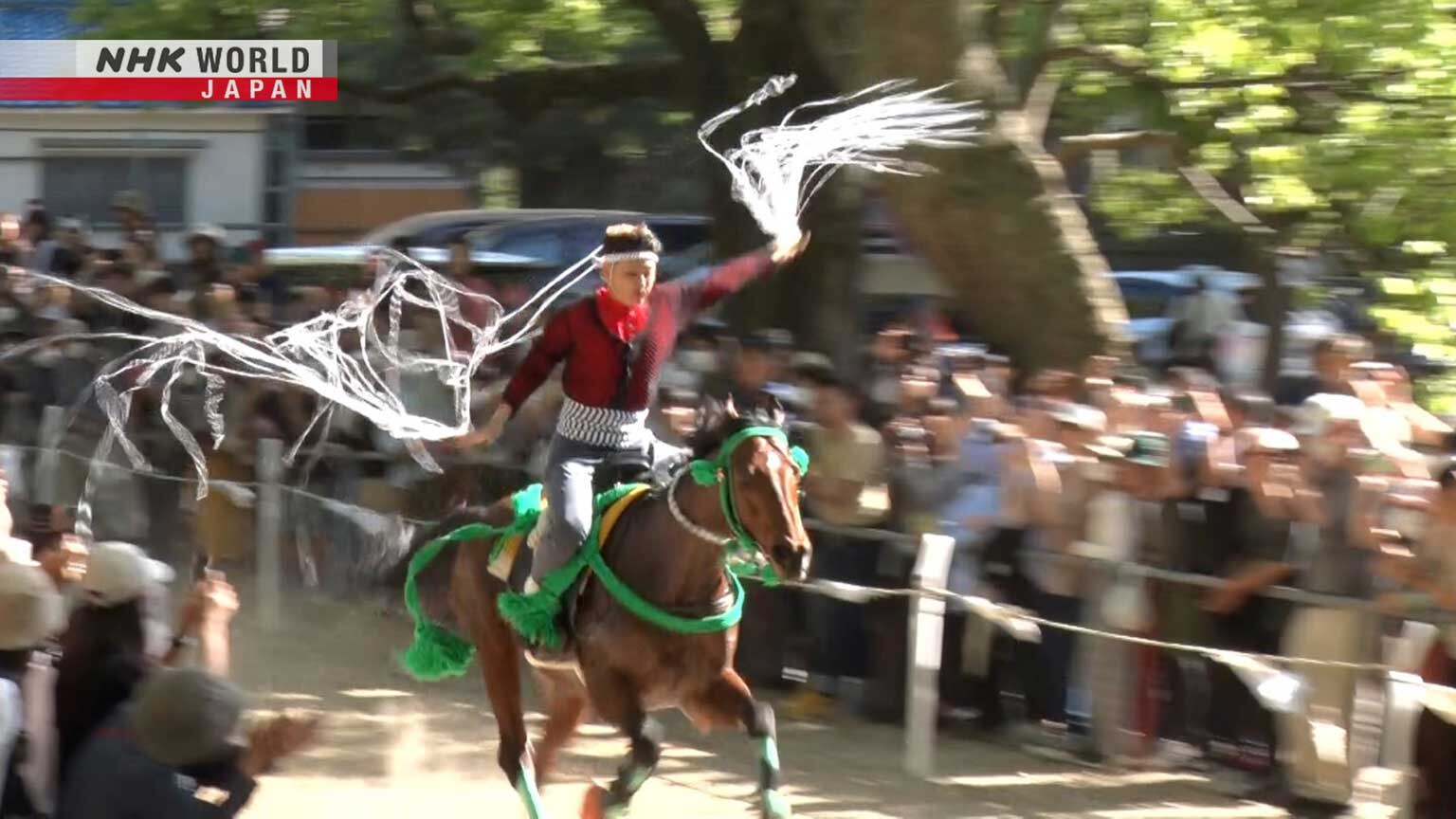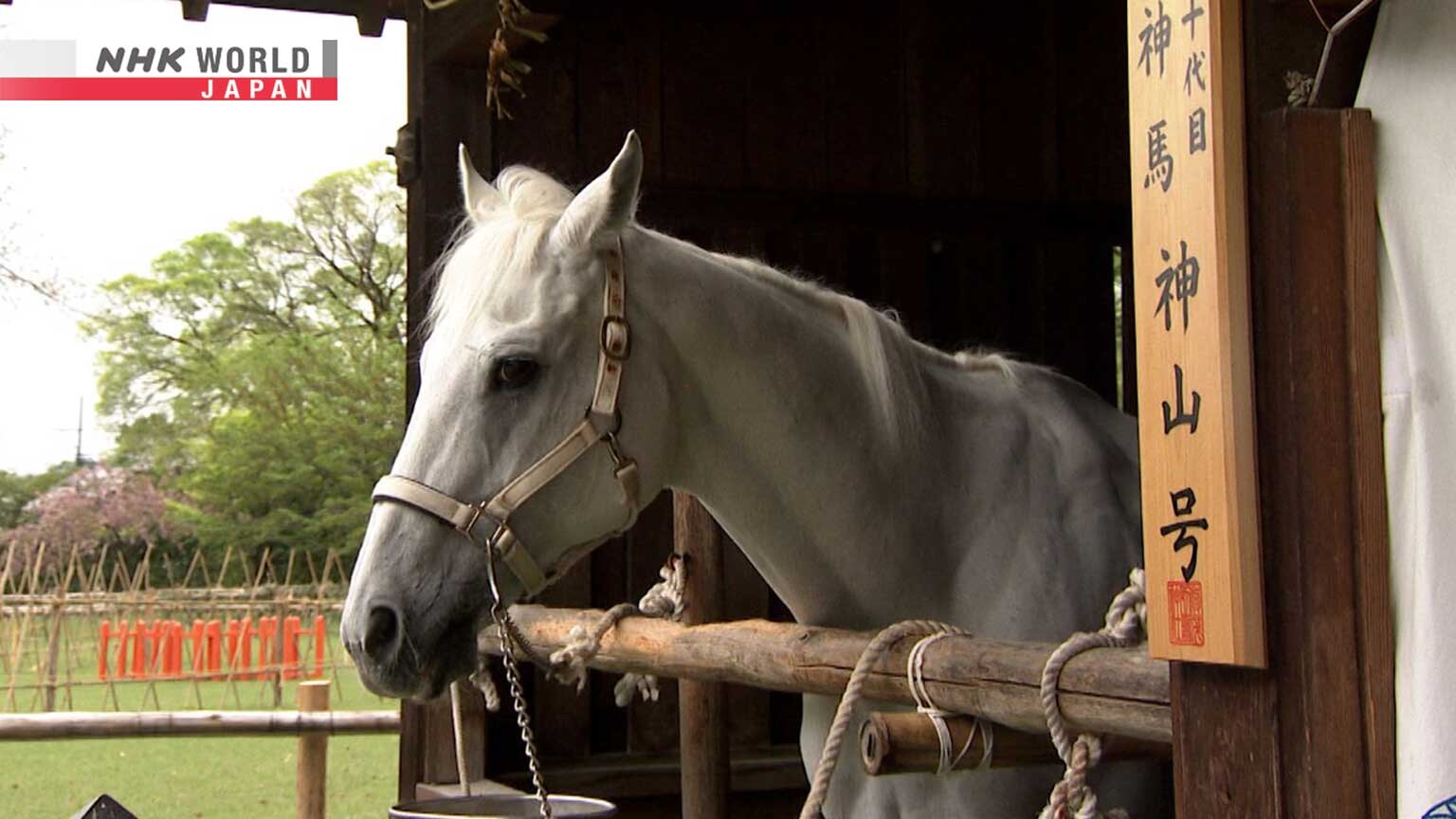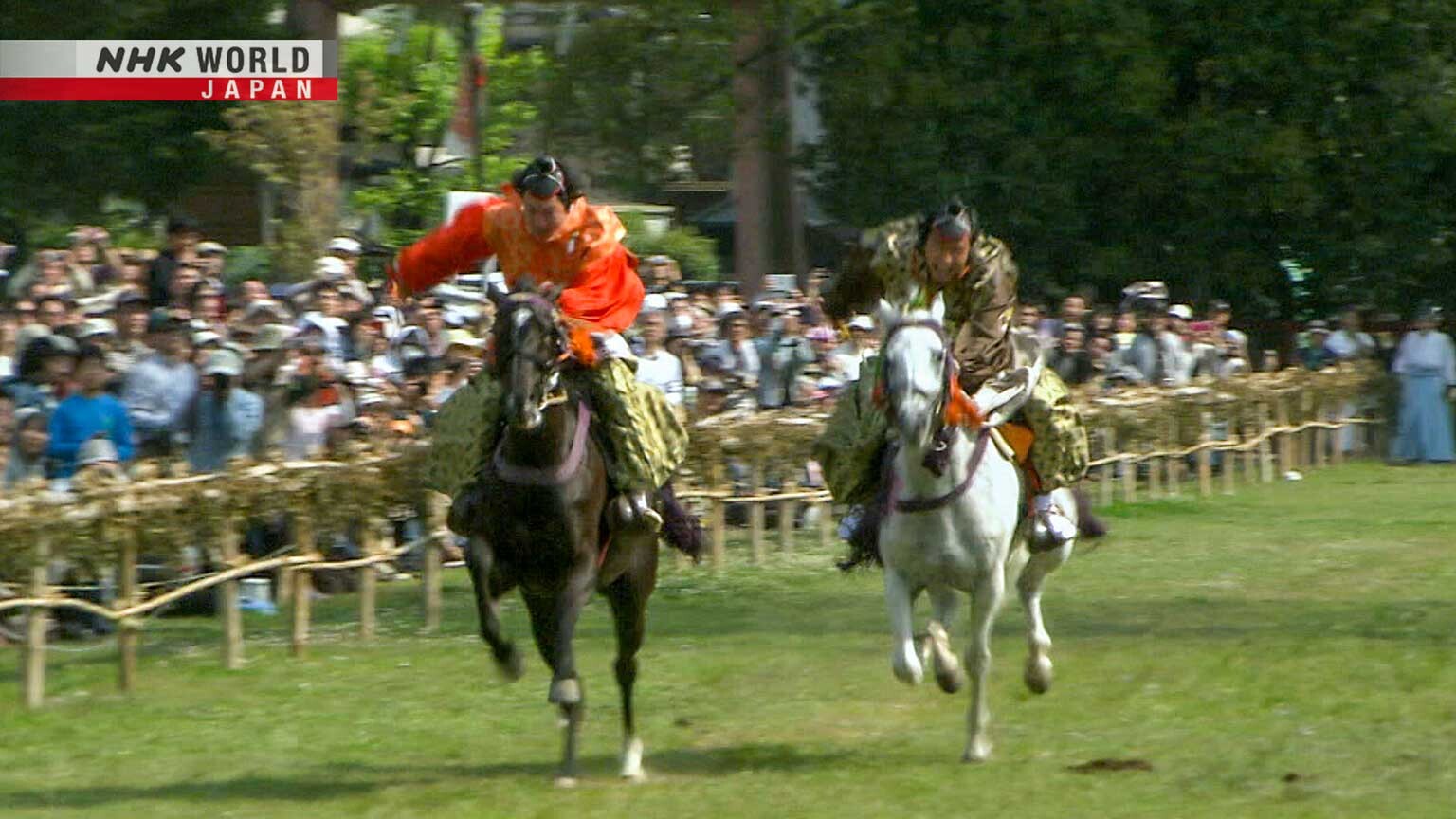Festival Horses: Galloping for the Deities in Shinto Rituals
Horses take center stage in the ancient capital's events, such as two May festivals—Aoi Matsuri boasting ornate historical attire and the 1,200-year-old Fujinomori-sai.




Transcript
Equestrians have been devoted participants in annual Shinto rites.
Facing danger on the fly, generations have performed for the deities.
None of us work with horses in our professional lives.
We all pull together for the sake of the festival.
It's that simple.
Horses figure prominently in various Shinto rituals in the ancient capital.
Steeds exhibiting swiftness and beauty were seen as messengers of the deities.
They were regarded with awe, and rituals involving them date back to around a millennium.
We can't let this custom die. We must pass it on as it is.
That's the meaning of preserving tradition.
Horse and human become one in the presence of the deities.
Core Kyoto explores the culture of equestrians and steeds
as they fulfill ancient roles in Shinto rituals.
Kifune Jinja has a heritage dating back some 1,600 years.
Legend suggests it began as a small shrine built by the mother of Japan's first emperor.
The sanctuary worships the deity of water, the source of all life.
Imperial envoys prayed here for the nation's peace.
Some Shinto shrines have statues of horses on their grounds.
Kifune Jinja is rare in that it has steeds of black and white.
Kifune Shrine was originally linked with rainfall.
The emperor would send a messenger offering a black horse to yield rain -
or a white one for sunshine.
The tradition began with live steeds, but it simplified into wooden plaques -
depicting horses, explaining today's votive tablets.
Today, these votive plaques are found at Shinto shrines throughout Japan, many exhibiting horses.
Worshippers inscribe them with prayers or words of gratitude then hang them near the shrine.
I prayed for marital harmony.
Horses are deeply intertwined with the Shinto faith at the city's ancient shrines.
Kamigamo Jinja was founded in 677.
One of Kyoto's oldest sanctuaries,
the shrine has long been revered for bringing peace to the imperial court.
On holidays, a sacred horse known as a "shinme" greets arriving worshippers.
The Ashige breed is selected for its coat which whitens as the horse ages.
The role of the "shinme" was to transport the deities -
explaining its importance here at Kamigamo Jinja.
The "shinme" plays an integral role in shrine life.
One New Year ritual upholds the belief that sighting a white horse banishes evil spirits.
The Kamigamo "shinme" resides at nearby Kyoto Sangyo University throughout the year.
The university's equestrian club, multiple winner of national championships,
has raised "shinme" for over half a century.
Around 1965, Kamigamo Jinja revived festivals incorporating the "shinme."
They asked our equestrian club to provide a steed.
We've been overseeing care of "shinme" ever since.
Two club members currently tend the "shinme."
Since the steed was originally a racehorse, they train him to be calm around people.
The previous "shinme" was beautifully cared for.
I want to uphold the standard set by earlier club members.
We may be the only ones in Kyoto, and I'm proud to have this privilege.
The "shinme" is brought to Kamigamo Jinja at 10 a.m. on Sundays and holidays.
He is led to the stable along the main approach of the shrine.
Visitors are welcome to offer him carrots.
I felt the sanctity of the moment. I'm glad I met him.
Aoi Matsuri supposedly originated about 1,400 years ago
with a divine proclamation to banish evil spirits by racing horses.
The luxurious parade of costumes illustrates the splendor of the Heian aristocracy.
The Kamo Kurabe Uma horse race launches the parade at Kamigamo Jinja.
It goes back 930 years and involves two teams competing for speed.
- How was the race?
- We have a winner.
Custom dictates that more wins by the horse rider in red indicates a good year ahead.
The ritual is upheld by the Kamo clan, descendants of the shrine's priests.
Though clan members are now scattered geographically and vocationally,
they gather annually for the race.
The festival is huge, encompassing the entire grounds.
We're striving to ensure it continues for another millennium or two.
Practice for the May event begins in March.
Competitors run the entire course at full speed.
On this rainy afternoon, the members take their rehearsals indoors.
The riders practice on wooden horses in keeping with the tradition.
The manner in which the horses are ridden in the Kamigamo Kurabe Uma is elaborately defined.
This has continued for 931 years, but we missed two years during Covid.
That third year, it took tremendous energy to revive the event.
But we can't let this custom die. We must pass it on as is.
In a sense, that's the meaning of preserving tradition.
The Kamo clan proudly maintains its millennium-old lineage and traditions.
Fujinomori Jinja, which stands in the Fushimi area, had close ties to the imperial family and samurai.
Legend has it that the shrine was founded over 1,800 years ago.
Empress Jingu was passing through on her return from a battle she had won in Korea -
and heard that this was sacred land, inhabited by deities.
So, she founded the shrine and dedicated a large battle flag and armament.
Once the legend took root,
worshippers brought military and equestrian equipment as offerings,
and the shrine became known for conveying success in warfare.
This resulted in the horseback-riding ritual known as the Kakeuma Shinji.
In 781, the emperor's younger brother prayed for victory at the shrine
before travelling to the country's northeast to quell a rebellion.
This spawned a ritual demonstrating sophisticated battlefield equestrian skills as a prayer for nationwide peace.
That event continues today at the shrine's main approach.
Riders perform acrobatics while racing their steeds along the 180-meter course.
The Kakeuma Preservation Society, which keeps the tradition alive, practices one month in advance.
Two horses are brought in for this one day.
The tack they use is comprised of traditional items handed down over generations.
This type of saddle was used by 15th- and 16th-century warriors.
Today, we will stand in place and review acrobatic style.
The society members are shrine parishioners who divide up the roles of rider and steward.
We all consider it our responsibility to pass these traditions on to the next generation.
It's not easy, but we all work day and night, sharing that goal.
This is the only day for rehearsal.
Moreover, the riders will not experience the actual track,
nor meet their horse, until the actual day.
Of course I'm afraid, and I've been told that if I lose that fear, I will fall.
So all I want to think about is mastering the skill.
Okada Toshiaki, now 67, began riding at age 13, perfecting his skills for over half a century.
He reluctantly retired two years ago, but he remains involved as a coach.
This year, as the race approaches, his mind increasingly focuses on one thought.
The festival makes me regret retiring.
Because if I don't ride, who will?
He does though consider riding again if his physical condition allows.
Fujiwara Yuuki is currently the oldest rider.
He is in his early 40s.
Following in his father's and grandfather's footsteps,
Fujiwara is best known for the Weeping Wisteria trick,
fooling the opponent into believing he has been struck by an arrow.
Fujiwara's two sons carry on the family skills.
I'm the third-generation rider, so these two are the fourth.
They said they want to ride, so now is their chance.
13-year-old Shinjiro, his second son, made his debut in 2024.
I really wanted to ride like the rest of my family.
I'm excited to join them.
A few days after the rehearsal, the Fujiwara family reviews videos of past riding events.
Since there are no actual practice runs, these sessions are critical.
I'm grateful that my children want to participate in a traditional event.
Still, it's a tradeoff, because I'm terrified that they may be severely injured.
My heart races every year.
Since they're risking their lives, I just hope they make it through safely.
Fujinomori Jinja hosts its eponymous festival on May 5th.
It originated as a festival to ward off evil spirits with the scent of irises.
The festival traces back to the mid-9th century
with prayers for the emperor's longevity and peace throughout the land.
Portable shrines transporting the deities are carried out in the morning.
Crafted in 1799 by parishioners who pooled their wealth,
they retain their resplendent appearance even today.
The drum and fife corps, and samurai warriors that follow the portable shrines, are also local residents.
The parade exits the shrine, enlivening the town as it passes by.
After the procession has left,
the Kakeuma Preservation Society prepares the grounds for the main event to come.
Okada, who retired two years ago, is on hand to assist,
dressed in the battle attire of a rider.
After 50 years riding, the body remembers what to do, so it'll work out.
But in the end, it's down to the horse.
As organizer of the riders,
Fujiwara offers younger members specific pointers on handling their mounts.
Once the horse sets off, go straight, just left of center. Got it?
The riders must be alert as they are running the event cold.
The horses arrive.
A contractor provides the horses, all of which are new to the event every year.
Fujiwara's eldest son Kotaro keeps an eagle eye on the situation.
This is his third year as a rider.
It's scary, and the tension is rising.
But the only thing I can do is picture myself riding well.
By 1 p.m., thousands of festival-goers have filled the approach to the shrine and the event begins.
There are seven traditional riding tricks.
As new horses participate each year,
the riders abandon tricks if the timing feels off.
The rule is strictly enforced to minimize risk.
Fujiwara Yuuki is the first rider this year.
He makes the first run without performing a trick to acclimate the horse.
The simple run identifies the start and end points for the horse,
while the rider assesses the animal's personality and condition.
Next, Fujiwara's second son Shinjiro makes his debut.
I was so tense that I don't remember a thing.
The horse just flew.
Riders begin the tricks once the horses get the feel of the event.
Veteran-rider Okada Toshiaki decides to make a comeback.
Biting down on a short sword,
he tries the Under the Bridle trick in which he is dodging enemy arrows.
Okada thought he was performing the trick like clockwork until he accidentally dropped the sword.
Nevertheless, his well-honed skills enabled completion of the trick.
It has been three years.
The sword hit the horse's head and fell.
Maybe I'll try it again.
Every year, Murata Hiroto attempts a new trick.
This year, he has chosen to write one kanji in calligraphy on horseback.
During battle, a single written character quickly updated allies on the enemy's status.
Here, the "backward horse" is an auspicious kanji.
This year, the horse ran a bit slower, which helped.
In the end, unity between man and horse is key.
The event originally demonstrated the great horsemanship needed in battle.
The preservation society members perform with amazing skill,
looking as if they have been practicing for weeks.
Fujiwara's older son Kotaro is next in line to ride.
Kotaro flaunts his skill in galloping past the enemy while repelling their arrows.
I'm glad I got through it safely.
Unfortunately, the horse wasn't up to the Weeping Wisteria trick this time.
This is the third year for Okada's grandson, Kota, to ride.
It's scary to ride, but that makes you more likely to fall, so I try to overcome it.
This year, Kota will try the Under the Bridle trick his grandfather perfected.
Great job!
I felt great when I finished. I didn't fall - that's the main thing.
After observing his grandson, Okada takes another turn.
He takes off, knife between his teeth.
Nobody would imagine the 67-year-old had not done this for two years.
Fujiwara closes the ritual.
His signature trick, the Weeping Wisteria, went off without a hitch.
It was my first time.
The galloping horses were so powerful, and the tricks were amazing.
The locals treasure the festival. The excitement was palpable.
I'm happy no one was hurt.
We succeeded in showing the next generation this offering to the deities.
Can I do this again?
Until you're 70.
- Three more years?
- You can do it.
No comment.
Horses have bridged the gap between humans and the deities since antiquity.
They eminate a divine aura during rituals in the ancient capital.
Bearing their riders' mission, the horses valiantly race into the future.